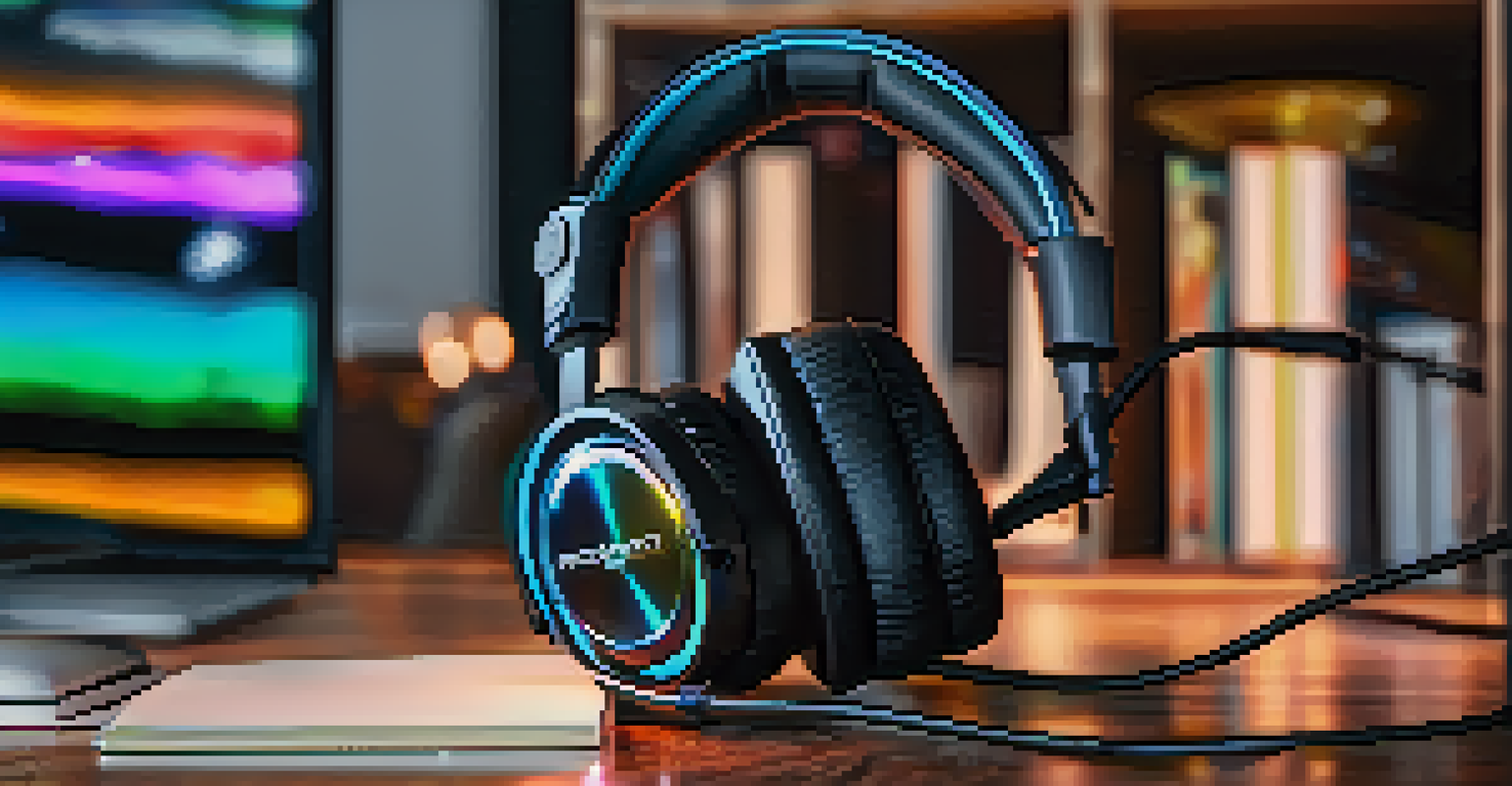3D Audio Technology: Enhancing Immersion in Games

Understanding 3D Audio Technology and Its Basics
3D audio technology creates a sound environment that mimics real life, allowing players to feel truly immersed in their game worlds. Unlike traditional stereo sound, which only provides two channels, 3D audio uses advanced techniques to simulate sound coming from all around you, including above and below. This rich auditory experience enhances the emotional connection to the game, making every explosion, whisper, and rustling leaf feel more impactful.
Sound is the essence of the gaming experience. It pulls you in, makes you feel, and connects you to the world around you.
For instance, imagine walking through a dense forest in a survival game. With 3D audio, you can hear the rustle of leaves behind you, making you constantly aware of your surroundings and heightening your sense of urgency. This level of detail transforms gameplay from merely visual to a multi-sensory adventure, engaging players on a deeper level.
This technology relies on various methods, including binaural recording and spatial audio processing. These techniques ensure that sounds are perceived in a way that reflects their true location in the game world, providing an experience that is both realistic and captivating.
The Evolution of Audio in Gaming
Historically, audio in video games has evolved from simple beeps and boops to fully orchestrated soundtracks, but the leap to 3D audio marks a significant milestone. In the early days, sound was often limited due to hardware constraints, leading to a flat and two-dimensional experience. As technology advanced, developers began to incorporate richer soundscapes that gave players a taste of immersion.

The introduction of surround sound systems was a game-changer, allowing players to experience audio from different directions. However, it wasn't until the development of 3D audio technologies that sound could be accurately placed in a three-dimensional space, enhancing the overall gaming experience. This progression highlights the industry's commitment to creating more engaging and realistic environments.
3D Audio Transforms Gaming Experience
3D audio technology immerses players in a realistic sound environment, enhancing emotional connections and gameplay dynamics.
Today, many games utilize 3D audio technology, showcasing how far we've come. Titles like 'The Last of Us Part II' and 'Half-Life: Alyx' exemplify how immersive sound can elevate storytelling and gameplay, providing players with an unforgettable auditory journey.
How 3D Audio Enhances Game Mechanics
3D audio isn't just a luxury; it's a vital part of gameplay mechanics in modern games. By accurately placing sounds in a three-dimensional space, players can use audio cues to navigate their environments and make strategic decisions. For example, hearing footsteps approaching from behind can prompt a player to take cover or prepare for an ambush.
3D audio immerses players in ways that traditional sound cannot; it transforms gaming into a multi-sensory experience.
This auditory feedback can significantly impact gameplay, as it provides essential information that visual cues alone may not convey. Imagine playing a stealth game where the sound of a guard's movements can determine your next action; 3D audio allows players to react quickly and precisely based on what they hear.
Moreover, 3D audio technology also enhances cooperative gameplay experiences. When team members can communicate effectively through spatial audio, they can coordinate strategies and movements more efficiently, making teamwork feel more natural and intuitive.
The Role of Headphones in 3D Audio Experiences
While 3D audio can be experienced through various sound systems, headphones play a pivotal role in delivering the most immersive experience. Binaural audio, specifically designed for headphone listening, creates a sense of space and depth that is hard to replicate with speakers. This auditory illusion tricks the brain into perceiving sound as coming from specific locations around the listener.
Using headphones with 3D audio technology allows players to appreciate the subtle nuances in sound design. For instance, the gentle buzz of insects or distant thunder becomes a part of the game's atmosphere, enhancing immersion. This attention to detail can transform a gaming session into a truly captivating experience.
Headphones Enhance 3D Audio Immersion
Using headphones with binaural audio helps create a spatial experience, allowing players to appreciate subtle sound details.
Many gaming headsets are now designed with 3D audio capabilities, making it easier for players to access this advanced sound technology. As a result, players can enjoy richer, more engaging soundscapes that elevate their overall gaming experience.
Popular Games Utilizing 3D Audio Technology
Numerous games have embraced 3D audio technology, showcasing its potential to enhance player immersion. Titles like 'Ghost of Tsushima' and 'Resident Evil Village' utilize spatial audio to create a more realistic and engaging atmosphere. In these games, players can hear the subtleties of their environment, from the rustling of grass to distant gunfire, making every moment feel alive.
Another prominent example is 'Doom Eternal,' where the combination of fast-paced action and 3D audio heightens the adrenaline rush. Players can accurately pinpoint the location of enemies and navigate hectic combat scenarios, leading to a more satisfying gameplay experience. This level of sound design contributes significantly to a game's overall quality and player enjoyment.
As the gaming industry continues to evolve, more titles are likely to adopt 3D audio technology, pushing the boundaries of what immersive gameplay can offer. The success of these games demonstrates the importance of sound in storytelling and player engagement.
The Future of 3D Audio in Gaming
As technology continues to advance, the future of 3D audio in gaming looks promising. We can expect further developments in audio engines that will enhance how sound is created and experienced in games. Innovations like adaptive audio, which adjusts based on player actions and environmental changes, will make gaming experiences even more dynamic and engaging.
Additionally, with the rise of virtual reality (VR) and augmented reality (AR), 3D audio will play a crucial role in making these experiences feel more realistic. In VR, for instance, accurately placing sounds in a 3D space is essential for immersion; players need to hear sounds as if they’re genuinely occurring in their surroundings.
Future Innovations in Audio Technology
Advancements in 3D audio will drive more dynamic and immersive gaming experiences, especially in virtual and augmented reality.
The gaming industry is already exploring these possibilities, and as more developers prioritize sound design, we can anticipate even more creative and immersive gameplay experiences in the years to come. The future of gaming is not just about what players see; it's also about what they hear.
Conclusion: The Impact of 3D Audio on Gaming
In conclusion, 3D audio technology represents a significant leap forward in creating immersive gaming experiences. By simulating sound in a three-dimensional space, it allows players to engage with their games on a deeper level, enhancing both the gameplay and emotional connection to the story. As we’ve seen, the integration of 3D audio in modern games has transformed how we experience sound and gameplay.
The evolution of audio in gaming reflects the industry's commitment to innovation and player engagement. With the increasing popularity of 3D audio, we can expect future games to leverage this technology even further, providing players with unprecedented levels of immersion and realism.

Ultimately, as sound continues to play a crucial role in gaming, 3D audio technology will remain at the forefront of enhancing player experiences, making each gaming adventure more memorable and impactful.